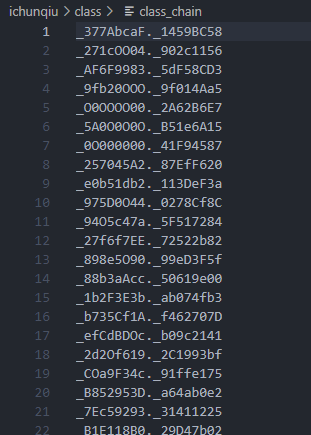春秋杯夏季赛WriteUp
白日梦主义 | 2024.07.06
做了勒索病毒,class,Signature,ezzzecc的题目
勒索病毒
BlackBasta勒索病毒,在https://www.nomoreransom.org/zh/decryption-tools.html获取解密工具

banana应该是被加密的文件。将解密工具上传,按照公众号提示代码即可解密
shell
sed -i 's/flags/"flags"/' ./decryptblocks.py
export SRL_IGNORE_MAGIC=1
./decryptblocks.py ./banana.jpg.sah28vut5 ./key.block要注意的就是要将文件后缀改回jpg,才能被系统检测到

可以看到/flag已经变为可读权限
获取得到flag

class
下载附件,里面巨多的class,一共11463个
从os.system向上统计利用链
python
# 初始化字典
classes = {}
caller_map = {}
# 读取文件并解析类和函数信息
with open("./class", "r") as f:
# 跳过前三行
next(f)
next(f)
next(f)
# 逐行读取剩余的内容
for line1 in iter(lambda: f.readline(), ''):
# 提取类名和函数名
class_name = line1.split("class ")[1].split("():")[0]
func_name = next(f).split("def ")[1].split("(self):")[0]
# 检查类名是否唯一
if class_name in classes:
raise ValueError(f"duplicate class: {class_name}")
classes[class_name] = func_name
# 检查条件是否为真
cond = next(f).split("if ")[1].split(":")[0]
if not eval(cond):
raise ValueError(f"condition not true: {class_name}")
# 读取调用函数的名称
callee = next(f).strip().split("(")[0]
caller_map[callee] = f"{class_name}.{func_name}"
# 跳过接下来的两行
next(f)
next(f)
# 初始化追踪变量和字符串
cur = "os.system"
class_str = ""
func_str = ""
all_str = ""
cnt = 0
# 追踪函数调用链
while cur in caller_map:
cur = caller_map[cur]
class_str += cur.split(".")[0]
func_str += cur.split(".")[1]
cnt += 1
all_str += cur.replace(".", "")
# 输出结果
print(cnt)
letters = set(all_str)
print("".join(sorted(letters)))
输出的所有类名包括的字符有0123456789ABCDEFO,考虑可能是将大写字母O替换为数字0
python
class_str = class_str.replace("O", "0")
func_str = func_str.replace("O", "0")
all_str = all_str.replace("O", "0")发现文本类似于7z文件的文件头,将类名和函数名拼接写入7z文件。尝试解压,发现flag.png,成功


Signature
首先分析server.py,就是标准的DSA签名算法
给了8次生成签名的机会,一开始还以为是根据这8次的结果进行共模攻击爆出私钥,后来发现私钥居然直接给了
那就很好办了,首先看第一步拦住的gift部分
python
def gen_proof_key():
password = 'happy_the_year_of_loong'
getin = ''
for i in password:
if random.randint(0, 1):
getin += i.lower()
else:
getin += i.upper()
ans = hashlib.sha256(getin.encode()).hexdigest()
return getin, ansgift就是密钥哈希的前六位,因为密钥就2^23的复杂度,直接嗯爆破就行
python
import hashlib
from Crypto.Util.number import *
def find_password(prefix):
password = 'happy_the_year_of_loong'
for i in range(2 ** len(password)):
binary = bin(i)[2:].zfill(len(password))
guess = ''.join([password[j].lower() if binary[j] == '0' else password[j].upper() for j in range(len(password))])
hashed = hashlib.sha256(guess.encode()).hexdigest()
if hashed.startswith(prefix):
return guess
return None
prefix = 'd1283c'
password = find_password(prefix)
if password is not None:
print(f'Found password: {password}')
else:
print('Password not found.')
登陆进系统,首先选择3查看生成的DSA密钥

然后输入2,可以直接获得私钥pri

直接用原函数对admin用户进行签名即可
python
import os
import hashlib
from Crypto.Util.number import *
def sign(m,pri):
k = int(hashlib.md5(os.urandom(20)).hexdigest(),16)
H = int(hashlib.sha256(m).hexdigest(),16)
r = pow(g,k,p) % q
s = pow(k,-1,q) * (H + pri * r) % q
return r,s
p, q, g = (num_p,num_q,num_g)
pri=655018296087138234606329472360813287552422912919
name = 'admin'.encode()
text=sign(name,pri)
print(text)
登陆进系统,直接吐出flag了

ezzzecc
按照题中要求,已知a、b、K、G,可以暴力算出私钥k,因为k小于1000000,在可穷举的范围内
python
E = EllipticCurve(GF(p),[a,b])
K = E(K)
G = E(G)
k = 0
for i in range(1000000):
if(i*G==K):
k = i
break然后正常进行解密即可
python
c1 = E(c1)
c2 = E(c2)
m = c1 - k * c2
print(cipher_left//m[0])
print(cipher_right//m[1])计算得出私钥k和解密的明文

最后将两部分转码成ASCII码,即为flag的左右两部分,拼接得到flag{2d6a7e4e-02d3-11ef-8836-a4b1c1c5a2d2}